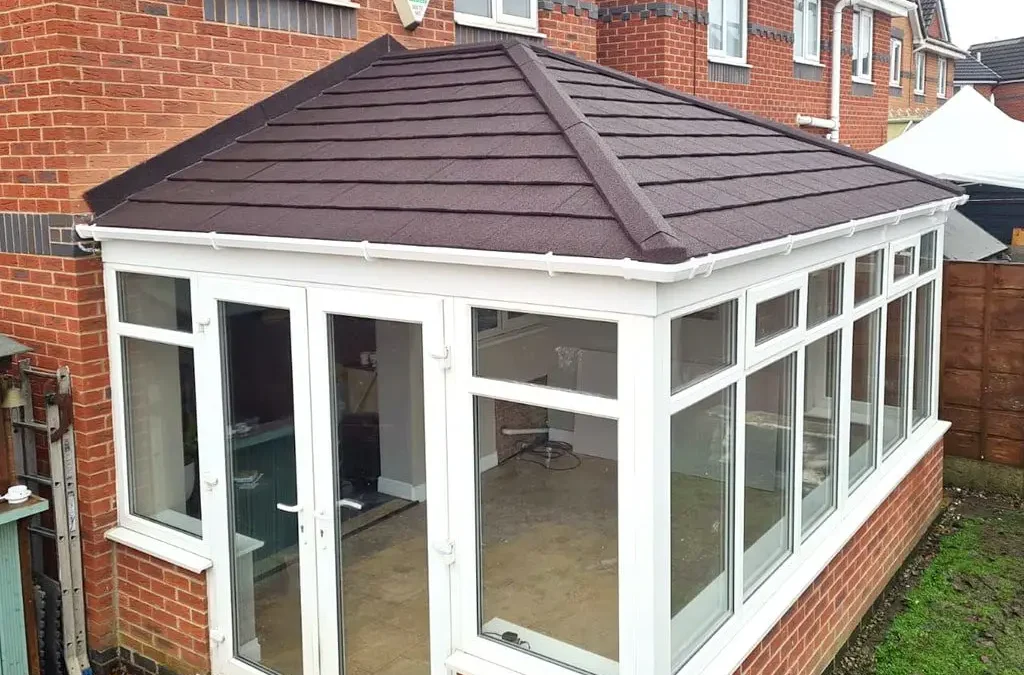
What Is the Range of Pitch for a Lean-To Conservatory Roof?
In this guide, we’ll walk you through the ideal pitch range for a lean-to roof and explain how it affects both performance and longevity. By understanding the right pitch for your conservatory, you’ll be able to make a more informed choice. So you can enhance both the look and durability of your space.
What Is the Ideal Pitch for a Lean-To Roof?
For lean-to conservatories, the ideal roof pitch is between 12.5° and 30°. This pitch strikes a good balance of practicality and aesthetic appeal. The pitch you choose has a direct impact on both the performance of the roof and the overall aesthetic of your conservatory.
Here’s what you need to consider when deciding on the ideal pitch:
- Water Drainage: A roof pitch’s primary function is to direct water away from the structure. A steeper pitch ensures that rainwater flows off quickly, reducing the risk of pooling water and leaks. If the pitch is too low, water may accumulate, leading to potential damage.
- Building Regulations: Certain areas might need a minimum pitch. This is to follow local building rules and to ensure the structure remains structurally sound and drains well. Always check local guidelines before finalising your design.
- Aesthetic Balance: While the roof pitch is functional, it also impacts the look of your conservatory. A steeper pitch provides a more traditional, timeless appearance. Meanwhile, a lower pitch complements modern, minimalist designs. Consider how the pitch will harmonise with the architecture of your home.
Key Considerations for Choosing the Right Pitch
- If you live in an area with frequent heavy rainfall or snow, you may need a steeper pitch to ensure proper drainage.
- Ensure the pitch complements your home’s style and fits seamlessly with the design of your conservatory.
- Different roofing materials have specific pitch requirements. For example, slate roofing usually needs a steeper pitch to drain water properly. On the other hand, metal roofs can handle lower angles without issue.
How Low Can a Lean-To Roof Pitch Go?
Most lean-to conservatories typically have a roof pitch of 12.5° to 30°. You can choose a lower pitch, but you need to consider some essential factors before deciding. Lower-pitched roofs have a sleek, modern appearance. But they can also bring some challenges. It’s critical to address these to keep the roof working well over time.
As mentioned above, the minimum pitch for a lean-to roof is typically 12.5°, which is sufficient for basic drainage. However, going below this can lead to problems, as a pitch lower than 12.5° is essentially considered a flat roof. This can result in water pooling on the roof, which can increase the risk of leaks and damage.
Challenges with Low-Pitch Roofs
- With a low-pitch roof, rainwater doesn’t flow off as quickly, making it easier for water to accumulate. This increases the likelihood of leaks, rot, and water damage to the building’s structure.
- The flatter the roof, the harder it is to ensure that water doesn’t seep under the tiles. Even the best installation can eventually lead to moisture seeping through over time.
- Lower-pitched roofs may require extra structural support to avoid sagging. Additional beams or reinforcements may be needed to maintain the roof’s integrity.
If you’re thinking about a low-pitch roof, choose materials made for low slopes. Good options include membrane roofing or specially designed shingles. These materials provide waterproofing even at shallower angles, ensuring long-term performance.
How High Can a Lean-To Roof Pitch Be?
On the other hand, a lean-to roof can be pitched higher, up to 30°, depending on your preferences and the overall design of your home. While steeper roof pitches are linked to traditional styles, they can also complement a lean-to conservatory. This is perfect for creating a stunning, cathedral-style ceiling or a classic look.
- Improved Drainage: A higher pitch allows rainwater to drain off more efficiently. If you live in a place with lots of rain or snow, a steeper roof is best. It prevents water from sitting on top and helps your structure last longer.
- Better Ventilation: A higher roof pitch boosts airflow in the roof space. This keeps the temperature inside the conservatory more comfortable. Better ventilation keeps your space cooler in summer and more comfortable all year round.
- Aesthetic Appeal: A steeper roof pitch provides a traditional, timeless look. If your home has a classic or historical design, ensure the pitch of your lean-to conservatory roof matches your main house. This will create a seamless and harmonious look.
Benefits of a Steeper Pitch
- Higher pitches can offer more attic or storage space, depending on your design. This makes it a practical choice if you want to use the area efficiently.
- A steeper roof tends to be more durable. It offers better protection against harsh weather, including heavy rain, wind, and snow.
Higher pitches can create a dramatic look. However, it’s worth keeping the roof design in line with your home’s overall architecture. A steep pitch might seem odd in a modern or minimalist home. So, think about the overall design of your property before you decide.
Find the Perfect Roof Pitch Today
Finding the right pitch for your lean-to roof matters as it ensures your conservatory is practical and looks good. A well-chosen pitch helps with proper water drainage, reduces the risk of leaks, and provides long-term durability. With the ideal pitch range of 12.5° to 30°, you can enjoy a conservatory that performs well and blends seamlessly with your home’s design.
At Trade Price Conservatories, we offer DIY conservatory kits that you can personalise. With our team, you can effortlessly select the perfect roof pitch to match your space. Whether you prefer a sleek, modern design or a traditional pitched roof, we provide all the tools and materials you need to bring your vision to life.
Call 03316 304680 today or contact us for a free, no-obligation quote.


